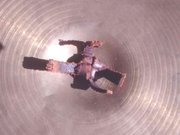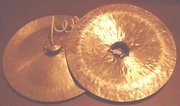Clash cymbals
|
|
Clash cymbals are cymbals used in identical pairs and are played by holding one cymbal in each hand and striking the two together. Sometimes they are called crash cymbals; See the article crash cymbal for the more usual use of this term.
| Contents |
Terminology
The technical term clash cymbal is rarely used. In musical scores, clash cymbals are normally indicated merely as cymbals. If another type of cymbal, for example a suspended cymbal, is required in an orchestral score, then for historical reasons this will be indicated explicitly, so the term cymbals is assumed to mean clash cymbals. Similarly in stage band situations, clash cymbals are normally just called cymbals, with other types indicated explicitly. In many other situations where clash cymbals are used, no other types are used so no confusion is possible, and again they are just called cymbals. Some composers and arrangers use the plural cymbals (or crash cymbals) to indicate clash cymbals, with the singular cymbal to indicate a supended cymbal.
Technique
Clash cymbals are conventionally played by a standing player. In preparation for a stroke they are held parallel a few inches apart, with the surfaces vertical, one at waist height and the other some distance above it. They are struck together by bringing the lower cymbal up while the upper is brought down, at the same time bringing them together but the main motion is vertical. A perfect stroke results in the entire rim of the cymbals touching at exactly the same instant, and they are allowed to rebound horizontally as they continue vertically.
If only a single crash is to be played, the sounding cymbals are then both raised in a follow through and held vertical but no longer parallel, but instead in roughly the same plane with their concave surfaces facing the conductor and held head high on either side of the player. This allows the maximum effect to reach the conductor and audience. Alternatively, if another stroke is to follow, the cymbals are allowed to follow through only until they have reached the same heights as they started (but now vertically reversed), and are then ready in position for the next stroke.
For softer strokes, in preparation the cymbals are held not quite vertically but at a slight angle, but still parallel, and the upper cymbal is then allowed to fall towards the lower. The follow through is reduced or even omitted after softer strokes.
Other common techniques are to choke the sounding cymbals by bringing them together and holding them with their entire rims touching, thus quickly damping their vibration, or to damp one or both against the body, and there are many more advanced techniques. A skilled player can produce elaborate rhythms by combining these techniques, and with fine cymbals can exercise precise control over both the loudness and the decay and apparent duration of each crash.
Less skilled players, children and cartoon characters are often seen playing cymbals by beating them together with a purely horizontal motion. This technique has even been used by some avant-garde composers, but generally produces poor control of the sound and risks damage to fine cymbals, which are not designed for such usage. Even most toy cymbals will produce a better effect with the classical technique, and even the youngest players will enjoy learning it - in the right mood!
Weights, tones and sizes
In the orchestra, clash cymbals are normally matched pairs of crash cymbals. They are commonly found in three weights:
- Francese, French, leggero or light, the lightest and thinnest.
- Viennese, medio or medium.
- Germanic, German, pesante or heavy, the heaviest and thickest.
Pairs in all weights range in size from 16" to 21" diameter. The smallest and thickest tend to have the higher pitch, the thinner ones allow for greater expression, and the largest the greatest volume.
Clash cymbals are also used in military, stage and marching bands, percussion ensembles, theatrical performances, and in state and religious ceremonies. These range in size from those of orchestral cymbals all the way down to about 5" in diameter.
Straps and alternatives
Orchestral clash cymbals and most band cymbals have leather straps passed through the holes in their bells, leading to four tails which are knotted inside the bell, to allow the player to hold them. Marching bands in addition use leather pads between the outsides of the bells and the player's hands.
Toy clash cymbals and some others have wooden or plastic handles instead; These should never be used with fine cymbals and can damage them. China type clash cymbals need no handles as the squared bells can be held quite securely without them, and are often joined by a cord through the holes in their bells which allows the player to release the bells after striking producing less damping and greater sustain, and to swing the cymbals producing doppler effects.



